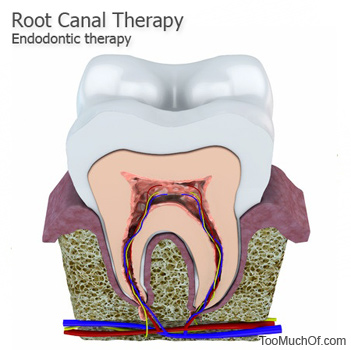
Root filled teeth become progressively more recognized as a threat to health. When your primary care physician tells you “it’s all in your head”, it very well might be.
When a tooth is endodontically treated, the nerve is removed and the pulp chamber of the tooth is sealed off. The bacteria entrenched inside the structure of tooth becomes uncontrolled and creates the potential for causing a high percentage of chronic degenerative diseases.
All teeth that have had root canal procedures remain infected, regardless how many times it has been done. This is mostly due to the microscopic canals within the tooth that cannot be reached by antibiotics and instruments. To adapt to the lack of oxygen, the bacteria transforms via a pleomorphic change to an anaerobic subtype. It becomes smaller and acquires ability to proliferate and multiply at higher rates. This type of bacteria produces sulfur containing compounds such as thioethers, which are considered one of the strongest poisons known, besides radioactivity.
Even if a sealed root canal tooth does not cause any significant discomfort and/or fistulas, and is completely “silent”, it may still continue to harbor the pathogenic bacteria that releases extremely dangerous toxins into the blood stream.
A root filled tooth has no fluid circulating through it and the tubules structure becomes a transport pathway for an anaerobic bacteria, which consequently stays unaffected by antibiotics. The bacteria can move out into the surrounding tissues and further transported to other locations in the body via the bloodstream. It can then affect any organ, gland or tissue, colonizing and producing recurrent and chronic low grade infections. The degenerative diseases as a result may include unrecognized autoimmune conditions, arthritis, rheumatism, heart and circulatory diseases and nervous system dysfunctions.
The problem arises from the fact that it is practically impossible to extract the dead nerves completely and eliminate the residual bacteria within the tooth structure with the current antibacterial agents. Since there is a risk of toxicity from these compounds long term, the drug choices are limited.
Antibacterial agents that are used to fill the root canals are toxic long term, and the most commonly used are
- Gutta percha filling – statistically not very effective in reducing the bacteria growth, thus over 55% failure of treated teeth. It may also be contaminated with barium.
- Biocalex (formerly known as endocal) – causes breakage of teeth in many treatments.
- Calcium hydoroxide – highly toxic if used permanently inside the tooth. If the root canal procedure is still desired, the best option would be to leave the calcium hydroxide inside the chamber short term (up to 1 month) to eradicate bacteria, then remove it and seal off the root canal.
In summary, if remaining in good health is the objective, and especially in those who already have pre-existing conditions, a root canal procedure may only lead to further complications.
A chronically infected tooth as a result of root canal procedure may produce low grade inflammation that might not be easy to detect. Years can go by, without pain, or any visible issues, even on x-rays. However, the infection would proliferate through the tissues and continue infecting the blood stream. Since the bacteria enclosed within the sealed tooth transforms to survive without oxygen, an immune system becomes chronically activated, resulting in symptoms that might seem completely unrelated to oral health. The resulting illness may resemble a chronic viral illness or a systemic inflammation condition.
If an individual has had a root canal procedure done and experiences a systemic illness without a reasonable explanation, a more careful examination of the tooth is warranted.
Options after the tooth extraction
- Partial clip-in dentures (removable bridges) – This is the old-school method that has been proven to work although it may produce an unnatural appearance and contribute to a compromised hygiene.
- Bridge – requires filing down healthy teeth next to the extracted tooth and may cost several thousand dollars.
- Leaving tooth missing – undesirable as it will contribute to problems with gums, development of TMJ, sacro-cranial problems, decreased chewing ability which is critical for proper digestion. Gaps formed by missing teeth can be implicated in periodontal disease, infections and may affect a person’s ability to eat or speak normally.
- Titanium implants [srs] (require 6 months healing time after installation) – at this time there is no long term data how they affect health.The current issues with the implants are
- The implant’s rejection rate is about 25%. The rejection comes from peri-implantitis, an inflammatory condition of the bone around an implant which results in bone loss and eventual loss of the implant.
- Implants continue to be installed without bio-compatibility testing, and they are often used in extraction sites where inflammation is present
- Autoimmune diseases are often aggravated and even initiated with metal implants due to newly formed immune complexes
- An oral galvanism is a condition that occurs when two dissimilar metals are used. This drives the ions of metals into the gum tissues and generate electricity that affects the body and especially brain rhythms, creating an overstimulation. This is also true for silver fillings, metal crowns or any other metals present in the mouth. Chronic insomnia and metal taste in mouth are generally the initial symptoms.
Choosing your doctor
Finding a doctor with an education that takes into the account a biological health of the entire organism when approaching the oral health is of an utmost importance. Biological dentistry is a such approach. To find a biological dentistry specialist in your area may be challenging. Although about 50% of the dentists in the US abstain from using mercury fillings, only about 10-15% of these doctors fully understand other aspects of biological impact that comes with treatment of teeth and gums. Your local health food stores may provide you names of the dentists known in the area for holistic dentistry. If you are unable to find someone who practices biological dentistry in your area, call the dental office of your preference and inquire about the substances and methods used during the treatments such as mentioned on this page. Additional questions on the office practices would be
- Use of digital x-rays that use less radiation
- Amalgam-free feelings
- Metal-free crowns
- Serum compatibility of metal titanium posts
- Use of dental dam for mercury filling removal
- Avoidance of fluoride
- Use of full spectrum lighting when matching crowns and filling colors
Keeping your oral health
Oral health maintenance is the best method to prevent tooth cavities and root canals.
